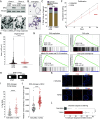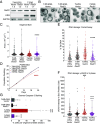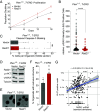RAD21 promotes oncogenesis and lethal progression of prostate cancer
- PMID: 39190349
- PMCID: PMC11388324
- DOI: 10.1073/pnas.2405543121
RAD21 promotes oncogenesis and lethal progression of prostate cancer
Abstract
Higher levels of aneuploidy, characterized by imbalanced chromosome numbers, are associated with lethal progression in prostate cancer. However, how aneuploidy contributes to prostate cancer aggressiveness remains poorly understood. In this study, we assessed in patients which genes on chromosome 8q, one of the most frequently gained chromosome arms in prostate tumors, were most strongly associated with long-term risk of cancer progression to metastases and death from prostate cancer (lethal disease) in 403 patients and found the strongest candidate was cohesin subunit gene, RAD21, with an odds ratio of 3.7 (95% CI 1.8, 7.6) comparing the highest vs. lowest tertiles of mRNA expression and adjusting for overall aneuploidy burden and Gleason score, both strong prognostic factors in primary prostate cancer. Studying prostate cancer driven by the TMPRSS2-ERG oncogenic fusion, found in about half of all prostate tumors, we found that increased RAD21 alleviated toxic oncogenic stress and DNA damage caused by oncogene expression. Data from both organoids and patients indicate that increased RAD21 thereby enables aggressive tumors to sustain tumor proliferation, and more broadly suggests one path through which tumors benefit from aneuploidy.
Keywords: DNA damage; RAD21; clinical outcomes; organoid; prostate cancer.
Conflict of interest statement
Competing interests statement:M.G.V.H. discloses that he is a scientific advisor for Agios Pharmaceuticals, Auron Therapeutics, iTeos Therapeutics, Droia Ventures, Lime Therapeutics, Pretzel Therapeutics, and Sage Therapeutics. L.A.M. reports research funding from Janssen and Astra Zeneca; serves on the scientific advisory board and holds equity interest in Convergent Therapeutics; and was a consultant to Bayer Pharmaceuticals. W.A. discloses honoraria from Roche, Medscape, Aptitude Health, Clinical Education Alliance, OncLive/MJH Life Sciences, touchIME, Pfizer, theMedNet; serves as a consulting or advisory role in Clovis Oncology, Janssen, Overcoming Resistance In Cancer (ORIC) Pharmaceuticals, Daiichi Sankyo, AstraZeneca/MedImmune, Pfizer, Laekna Therapeutics, MOMA Therapeutics, Endeavor BioMedicines.
Figures




References
MeSH terms
Substances
Grants and funding
- N/A/Paul F. Glenn Center for Biology of Aging Research
- Young Investigator/Prostate Cancer Foundation (PCF)
- N/A/HHMI (HHMI)
- N/A/MIT Center for Precision Cancer Medicine, the Ludwig Center at MIT
- N/A/Bridge Project, Koch Institute for Integrative Cancer Research at MIT and the Dana-Farber/Harvard Cancer Center
- CA014051/HHS | NIH | National Cancer Institute (NCI)
- CA228696/HHS | NIH | National Cancer Institute (NCI)
- N/A/PEER Award by the Zhu Center for Global Cancer Prevention
- Fellowship/Virginia and D.K. Ludwig Fund for Cancer Research (D.K. Ludwig Fund)
- CA167552/HHS | NIH | National Cancer Institute (NCI)
- P30 CA008748/CA/NCI NIH HHS/United States
- HD085866/HHS | NIH (NIH)
- Fellowship/Jane Coffin Childs Memorial Fund for Medical Research (JCC)
- HU0001-23-2-0008/Center for Prostate Disease Research Core Funding
- UH3 CA213392/CA/NCI NIH HHS/United States
- CA242379/HHS | NIH (NIH)
LinkOut - more resources
Full Text Sources
Medical
Molecular Biology Databases

